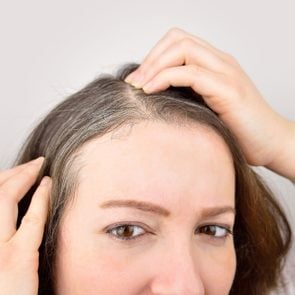This Is the Rarest Hair Color and Eye Color Combination in Humans
Updated: Jan. 03, 2024

If you have the rarest hair color and eye color combination, you're one in a million—or more!
Do you have dark brown hair and brown eyes? Then you have something in common with most people around the globe. According to the World Atlas, between 75% and 85% of the global population has dark brown or black hair, and 70% to 79% of people have brown eyes. It’s not exactly the rarest hair color and eye color combination.
So which combo is the least common? To understand that, we need to understand the science. As Julie Kaplan, MD, a physician at Cleveland Clinic’s Center for Personalized Genetic Healthcare, points out, knowing which genes play a role in hair and eye color variation can help us understand why some hues are more prevalent than others.
Keep reading to find out the rarest hair color, the rarest eye color and the rarest combination of the two.
Get Reader’s Digest’s Read Up newsletter for more knowledge, humor, cleaning, travel, tech and fun facts all week long.
The rarest hair color
Red is the rarest hair color, but to understand why that’s the case, you need a basic grasp of the science. There’s a lot more to it than the simple traits we learned about in high school biology. Those lessons taught us that different versions of a gene can be dominant (what you see) or recessive (what you don’t see), and they helped explain things like why some people are born with blue eyes versus brown or green.
But that’s a simplistic view of eye color, and determining hair color is even more complicated. “Hair color is a bit more complex than dominant and recessive and is related to variants in the MC1R gene,” says Dr. Kaplan. “There are nine variants described in this gene.”
If that made you wish for recess, we don’t blame you. Luckily, Dr. Kaplan broke down the MC1R-hair color connection for us. Read on to learn why this single gene is so important in determining the hue of your tresses.
The hair-color gene
Your father has brown hair. Your mother’s a blonde. And you somehow ended up with flaming red hair. It’s all thanks to a single gene.
The MC1R (or melanocortin 1 receptor) gene helps decide your hair, skin and eye coloring. It sends signals to the melanocytes—cells that create melanin in your body—and depending on your genes, it creates eumelanin (usually associated with darker hair and skin) or pheomelanin (associated with light-colored hair, like red or blond, and fairer skin).
In redheads in particular, the MC1R gene doesn’t function the correct way and causes these cells to make mostly pheomelanin, which is barely present in any of the other hair colors. Interestingly, the lack of melanin also puts redheads at a higher risk for skin cancer.
And here are more fascinating facts about redheads: The reason red is the rarest hair color, according to Dr. Kaplan, is that, of the nine variants in the MC1R gene, only three are associated with the shade. “If a person has two of these three variants, they almost certainly have red hair,” she says. “If they only have one of the three variants, there is still a greater chance of red hair, though they may be more likely to have strawberry blond. The other six variants can lead to a range of blond to brown hair color.”
So while blondes may have more fun, redheads are halfway to having the rarest hair color and eye color combination.
Another reason red hair is so rare
While the MC1R gene is the dominant decider of hair color, it isn’t the only one. According to a 2018 study published in Nature, the OCA2 gene, which is important for eye color, also interacts with the MC1R gene and can reduce your likelihood of having red hair.
The rarest eye color
According to an American Academy of Ophthalmology survey, green eyes are the rarest. Only 9% of Americans have green eyes, compared with 45% who have brown eyes and 27% who have blue eyes.
But it’s not quite that simple.
See, we like to think there’s a rainbow of eye color options out there—violet, blue, gray, hazel, green, brown, near-black—but scientists believe that they’re all slightly different manifestations of blue eyes or brown eyes. “It may seem like green is rare,” says Dr. Kaplan, “but there are many people who have green-brown eyes.”
The eye-color gene
Just as the MC1R gene determines your hair color, a single gene, OCA2, is 75% responsible for your eye color, Dr. Kaplan says.
For eye color, the OCA2 gene determines how much melanin is in the iris (the colorful ring around your pupil) by controlling how much P protein is produced. For people with blue eyes (considered a recessive trait), there’s very little P protein. “Two nonfunctional copies of OCA2 yield blue eyes,” says Dr. Kaplan. “If a person has two functional copies of OCA2, they are more likely to be on the spectrum of blue-green-hazel brown.”
Other genes that play a role in eye color
OCA2 isn’t the only gene that has a say in what color eyes you’re born with. There’s HERC2, a gene that controls how the OCA2 gene works, essentially turning P protein production on and off.
And there are eight additional genes that play at least a small role in eye color, which makes determining what eye color any particular baby might have extremely hard—even if you try to base it on their parents or grandparents. A pair of blue-eyed parents can still have a brown-eyed child, depending on how all the genes interact.
Have you ever wondered if people with blue eyes are related? Here’s the answer.
The rarest hair and eye color combination
What is the rarest hair color and eye color combination? That’d be red hair with blue eyes.
There’s a little genetic tweak that makes the combination of red hair and blue eyes the rarest of them all. The same Nature study mentioned above found that another gene variant, HERC2, interacts with both the MC1R gene and the OCA2 gene—and it can shut off the redhead gene while expressing blue eyes and blonde hair. That makes the blue eye and red hair combination even more unlikely to happen.
In addition, with both red hair and blue eyes being something akin to recessive traits, having parents who are able to pass on two sets of recessive genes is very unlikely. In most cases, you’d have blue eyes and hair somewhere on the spectrum of blond to brown or red hair with brown, hazel or green eyes.
According to an article by evolutionary biology professor Mark Elgar, PhD, of the University of Melbourne, blue-eyed redheads are the absolute rarest, with 0.17% of the population having that combination of hair and eye color. So if that describes you, you’re most likely one in a million—or more!
About the expert
- Julie Kaplan, MD, is board certified in both pediatrics and medical genetics and genomics. She is currently a physician at the Cleveland Clinic’s Center for Personalized Genetic Healthcare.
Sources:
- World Atlas: “The World’s Population by Eye Color”
- World Atlas: “What Percentage of the World’s Population Has Brown Hair?”
- Nature: “Genome-wide study of hair colour in UK Biobank explains most of the SNP heritability”
- American Academy of Ophthalmology: “Your Blue Eyes Aren’t Really Blue”
- University of Melbourne: “Are Redheads with Blue Eyes Really Going Extinct?”


